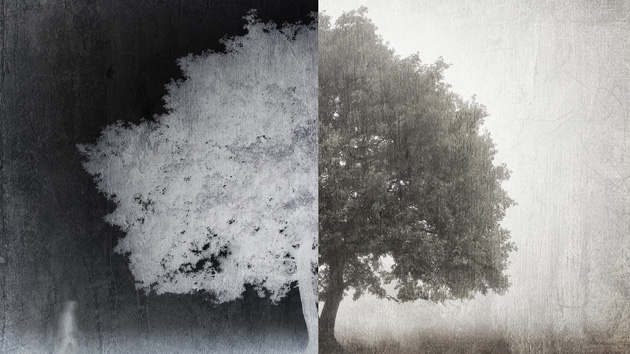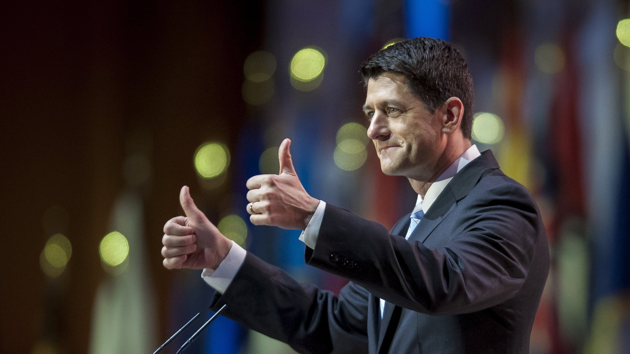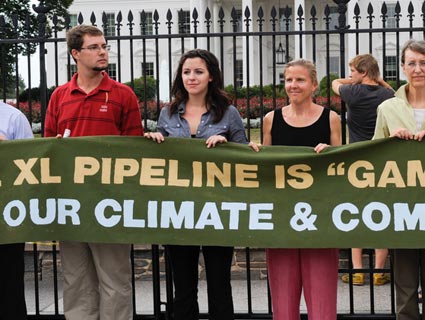
<a href="http://www.shutterstock.com/pic-90806777/stock-photo-lone-oak-tree-in-the-fog.html">Shutterstock</a>/Sunny Forest
This story was originally published on Grist.
Out of the rack and ruin of our gangster death,
The rape and rot of graft, and stealth, and lies,
We, the people, must redeem
The land, the mines, the plants, the rivers
The mountains and the endless plain –
All, all the stretch of these great green states –
And make America again!
– Langston Hughes, 1938
I really didn’t want to have to address this. While reading through University of Michigan professor Dorceta Taylor’s latest report, “The State of Diversity in Environmental Organizations,” and thinking about what I would write about it, I had hoped to focus on the solutions. Those solutions—confronting unconscious and subconscious bias and other subtle forms of discrimination—are the parts I had hoped environmentalists would be eager to unpack.
I thought they’d read about the “green ceiling,” where mainstream green NGOs have failed to create a workforce where even two out of 10 of their staffers are people of color, and ask themselves what could they do differently. I thought, naively, that this vast report, complete with reams of data and information on the diversity problem, would actually stir some environmentalists to challenge some of their own assumptions about their black and brown fellow citizens.
I was wrong.
Maybe I’m being too harsh. Some green leaders have taken this issue to heart. Frances Beinecke, president of the Natural Resources Defense Council, said in response to the report that the “environmental community has to do more,” and that, “Without collective action to create inclusive workplaces, broaden our community partnerships, and diversify our voice, we will not be equipped to confront the great environmental problems of our time.”
Michael Brune, executive director of the Sierra Club, responded that his group (which helped fund the report) is “working hard to ensure our organization looks like America.”
And yet, judging from the comments on my first story about the report—some from people who profess to spending years and even decades in the green movement—it appears that too many would rather accommodate their prejudices than test their understanding of how non-white, non-hetero, non-male, non-college-educated, non-wealthy human beings relate to the environment.
Worse, too many believe that those in these “non-” categories don’t have the skills or knowledge to be valuable to the environmental activism workforce. Too many believe the poor are too occupied with being poor, or black people are too occupied with being black to be occupied in green organizations.
Taylor’s report paints a different picture: “A significant number of talented ethnic minorities are willing and able to work in environmental organizations, but discriminatory hiring practices prevent them from obtaining jobs in such organizations.”
Her research not only proves this, but her MELDI website also does some of the work for employers, by listing hundreds of professionals of color with bona fide environmental pedigrees.
This week, a group of prominent environmental leaders of color also launched the Diverse Environmental Leaders National Speakers Bureau to draw attention to even more people of color working in the environmental field. If that wasn’t enough, Green for All also released results of a survey showing majorities in communities of color support action on climate change and environmental matters.
“There is a lot of rumor and speculation surrounding what people of color think about climate change and the environment,” Green For All Executive Director Nikki Silvestri said in a press statement this week. “People of color care deeply about the environment and the impacts of climate change. We understand the urgency of these threats because we experience the effects every single day.”
Protecting the environment we live in is not a novel concept for us. Consider the 1960s Harlem survey referenced in Taylor’s report, where residents were asked what they liked least about their neighborhoods. The top response from black Harlem was not low wages or police brutality; it was that they did not have enough trees and plants.
The conservationist Charles E. Little, who taught environmentalists most of what they know about “greenways” and green spaces, had a good sense of this. He was an early critic of those who drew “erroneous conclusions” and “simplistic assessments” about what people of color think of the environment. Taylor references his work, also.
Little was responding to studies in the 1960s where researchers argued that black and brown people’s own cultures held them back from being more active participants in what are traditionally recognized as environmental causes. It’s a tired argument used often as a convenient, if not lazy, way of hiking around the rockier points of racism and discrimination. It’s also a convenient way to filter people of color out of a job applicant pool.
***
One reason green groups have been suboptimal in connecting with people of color—and getting them on the payroll—may be that they are speaking a different language when it comes to the environment.
Check the history: In the wake of the 1968 assassination of Martin Luther King, civil rights activism was waning. Meanwhile, momentum was growing around ecological activism, with a lot of hype around organizing for Earth Day. Many African Americans were concerned that funds and resources needed for civil rights reforms were being diverted to new environmental causes. People of color didn’t necessarily oppose environmental activism; they just didn’t want it to come at the expense of civil and human rights.
Also, the environmental conversation at the time was obsessed with two things: pollution and population. On pollution, it appeared white people were more concerned with cleaning up and preserving uninhabited lands—or what was perceived as uninhabited—to expand parks and wilderness areas.
As noted in Taylor’s report:
Native Americans … disrupted Earth Day proceedings in 1970 to challenge the policymaking process by White environmentalists that left tribes out of decision-making processes related to Indian affairs. Gaylord Nelson, one of the sponsors and key supporters of the event, was greeted by Indian demonstrators who threw garbage on the stage and accused him of sponsoring legislation that would take land away from the Chippewa tribe to facilitate the creation of a national park.
And then there was the overpopulation alarm that drove many white people into the new environmentalism. The theory, made popular in 1968 by Paul and Anne Ehrlich’s book The Population Bomb, was that as population increases so does overconsumption and other human activities that wreak havoc on climate and habitat. People of color sensed—right or wrong—a more nefarious agenda here, though.
First, there were the political implications of population—with booming black and brown populations comes increased voting power. Since the 1965 Voting Rights Act prevented discrimination at the polls, their population increases could translate for many whites as a recipe for their loss of control over the government. Once you added in the history of sterilization experiments —like the eugenics project practiced on African Americans in North Carolina, which the state is paying reparations for today—black and brown Americans could not be blamed for thinking there was a racist element to this new environmentalism.
Ironically, black people in the 1960s were as concerned about overpopulation as their white eco-counterparts. After all, it was black and Latino Americans who were mostly living in overcrowded ghettos at the time, and dying from the pollution and disease that came with that. White environmentalists and population zealots, meanwhile, gave off the impression that it was the black and brown population itself that was the pollution problem—an idea that had existed since the beginning of nature conservation in America. If you don’t believe me, see Madison Grant.
The 1969 Rockefeller Report on Population Growth and the American Future dispelled many of these notions, stating, “the idea that our population growth is primarily fueled by the poor and the minorities having lots of babies is a myth.”
The responses the Rockefeller Commission collected in its own surveys on the topic were telling. Dr. Eugene S. Callender, president of the New York Urban Coalition, told the commission:
Minority groups must share the generally growing concern for the quality of life available to us as the population increases. However, it must also be kept in mind that minority groups have only recently been allowed to become participants in this system, to receive its benefits and to share in shaping its future. We are even more anxious about our position within the society, since our few gains are, even now, tenuous.
Another respondent said, “If this [ecology] movement also talks about fewer people, the question of ‘who gets to survive’ is raised. So, to us, it becomes ‘every man for himself’ now, because we have no reason to expect that we won’t get the worst of this one too.”
***
It was clear at this point that “environment” meant something different to people of different races. In the 1970 article “Black Ecology,” by Nathan Hare, who developed the first collegiate black studies program, he wrote:
The legitimacy of the concept of black ecology accrues from the fact that : (1) the black and white environments not only differ in degree but in nature as well; (2) the causes and solutions to ecological problems are fundamentally different in the suburbs and ghetto (both of which human ecologists regard as “natural [or ecological] areas”; and (3) the solutions set forth for the “ecological crisis” are reformist and evasive of the social and political revolution which black environmental correction demands.
Terry Jones took it a step further calling it “Apartheid Ecology” in the May 1975 edition of Black World:
[T]he popularization of the concept of ecology in everyday American life is potentially one of the most relevant forces imaginable in the ultimate liberation of Black America, and it has become such a force in spite (or perhaps because) of the fact that it blatantly overlooks Black Americans and their environmental interests.
While Hare and Jones were attempting to carve out a new definition of environmentalism that spoke more directly to black people’s lives, it turns out they may have been closer to the term’s true meaning to begin with. As Hare explained in his article, “[T]he word ‘ecology’ was derived by a German biologist from the word ‘aikos’ meaning ‘house.'”
This more urbanized rendering of the term is not some relic of the “Black Power” era. California State University professor Stephan Mexal, who I talked to for this story on the Central Park Five, wrote in the 2004 book, Eco-man: New Perspectives on Masculinity and Nature:
The recent spate of critical attention paid to environmental concerns has–perhaps unsurprisingly–tended to assume a rather narrow conception of what, exactly, constitutes the environmental. In its popular usage (for example, ‘trying to save the environment’), the term becomes roughly equivalent to natural or is simply used to signify the out-of-doors, the organic. But its etymological roots lie in the Anglo-French environner (loosely, to physically encircle), and as such it is crucial to reconnect our awareness of both the environmental and the ecological to a sociologically based understanding of proximate space. Proximate space is our immediate, familiar environment: not, for most Americans, a space of trees and streams and hills but rather a space of concrete and glass and steel.
***
So, historically there’s been somewhat of a language barrier between the races in the environmental movement. We define nature by what we see when we look outside. What a black child from Southside Chicago sees through her glass will be different than what a white child sees from her window in South Burlington, Vt.
But regardless of the lens and definitions, there are common understandings and goals across racial and social spectrums. The main commonality is the concern for future generations, which Taylor has pointed out in some her early research.
“It’s not necessarily that there is a ‘black ecology’ and ‘white ecology,'” Taylor said in an interview this week. “It’s just that our lived experiences with environment are different. White people bring their experience to the discussion — that’s why they focus on the birds, trees, plants, and animals, because they don’t have the experience of being barred from parks and beaches. It’s just a different frame. But overall, we want the same thing: safe places to live, work and play, clean spaces and sustainable, long-lasting communities.”
This was acknowledged in the 2005 report “The Soul of Environmentalism,” an environmental justice response to the doomsday report “The Death of Environmentalism,” which downplayed if not ignored the activism of people of color. The “Soul” report made many of the same points Taylor made in her most recent diversity study:
The mainstream environmental movement has been unable to racially integrate its senior staff, not because of overt discrimination but because of differences in vision. Many environmentalists of color admire the mainstream movement’s goals, but they also know firsthand that social justice is routinely ignored in the mainstream movement’s decision-making.
Similar points were made in the environmental justice movement’s 1990 letter to mainstream green groups, and also in the seminal “Toxic Waste and Race” report of 1987 that helped spur the movement into its own action. And yet some white environmentalists continued to believe that black and brown Americans’ absence among the environmental activism was due to their own lack of agency.
Again, Taylor doin’ the knowledge on this:
Research of this nature continued into the new millennia as scholars and environmental activists often depict ethnic minorities as disinterested in the environment and ignorant of environmental affairs. These studies also enshrined the idea that minorities were neither qualified for environmental jobs nor wanted such jobs (Taylor 2000a, 2007; 2008). This logic partly explains why racial diversity has been such a low priority for environmental organizations. If minorities are not interested in the environment, lack knowledge of it, are not qualified, and do not want to work in environmental organizations, why recruit and hire them? [Emphasis added.]
This is why it is so difficult to focus on solutions to the diversity problem—because too many are stuck on racial attitudes popularized when the Klan was chasing sweaty, bulging-eye, watermelon-devouring black sharecroppers through Jim Crow forests, as in the 1915 film Birth of a Nation. In that film, screened at the White House to President Woodrow Wilson’s applause, black people were seen as something separate from the vision of nature carried by many powerful white conservationists—President Wilson among them.
Black people were seen as crimes against this particular vision of nature, as were Native Americans before them. Since they could no longer be tamed and domesticated as slaves, they needed to be erased.
We’ve struggled for visibility and recognition among environmentalists ever since. When we created our environmental movement, it was ignored and underfunded. Why? Perhaps because too many white men have built a definition of “environment” that they’ve determined to be the only truth—a truth that for the rest of us, they believe, is simply not in our nature.
















